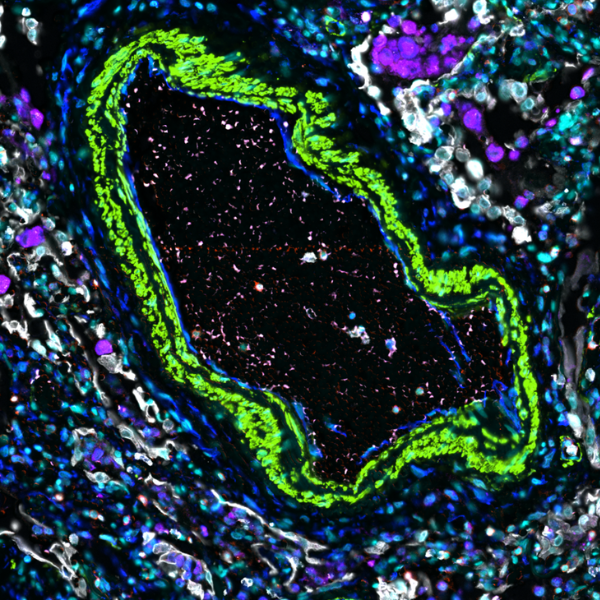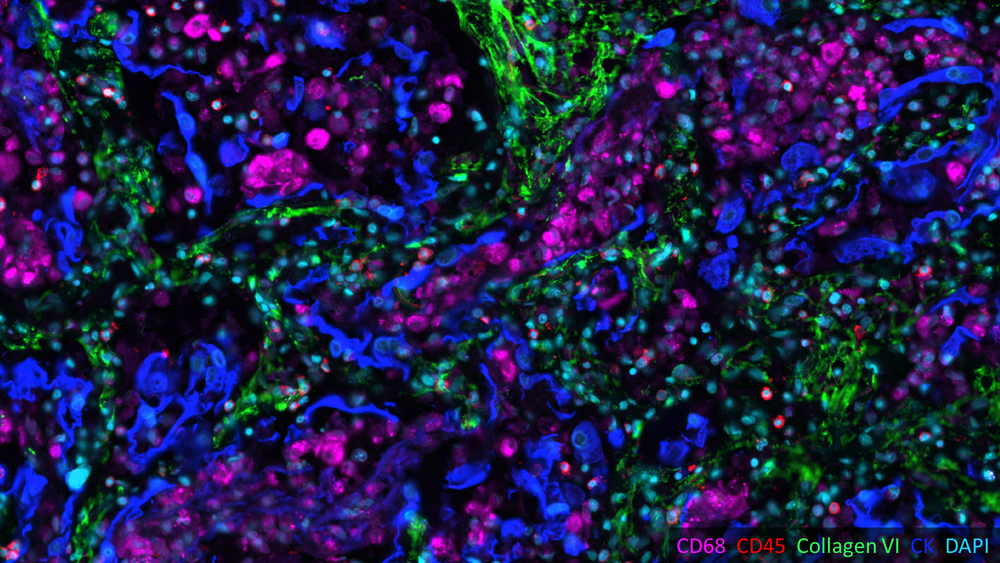press-releases
Leading research institutions present new data in COVID-19 and glioblastoma research using Lunaphore’s COMET™ technology at the IMMUNOLOGY2023™ Annual Meeting
Date

LAUSANNE, Switzerland – May 11, 2023 – 4:00 pm (CEST) – Lunaphore, a Swiss life sciences company developing technology to enable spatial biology in every laboratory, today announced new data shared in oral presentations within the scientific program and a symposium at IMMUNOLOGY2023™, the Annual Meeting of The American Association of Immunologists (AAI). The research, presented by The University of Birmingham and Northwestern University, showcases the use of spatial biology to investigate COVID-19 and glioblastoma, respectively.
In debut data related to the use of spatial biology in COVID-19 research, Dr. Matthew R. Pugh, FRCPath, of the University of Birmingham, shares a study titled Multi-omic spatial profiling in COVID-19 lung reveals temporal evolution of the disease and novel collagen VI biomarker for outcome, Pugh, M, et al. The abstract selected for a scientific symposium details the team’s research into the tissue response in the lungs of patients with COVID-19, conducting a multi-omic investigation in post-mortem lung tissue from fatal COVID-19 infection using multiplex immunohistochemistry on Lunaphore’s COMET™ as well as bulk Quantseq RNA sequencing, spatial transcriptomic profiling and in situ transcriptomics with RNAscope™. The novel and unpublished results demonstrate the power of post-mortem investigation and spatial profiling in elucidating clinically relevant insights into complex disease phenomena.

Dr. Pugh also presents data in a symposium, The immunopathology of COVID-19 placentitis: A spatial multi-omic approach, Pugh, M. et al., focuses on COVID-19 placentitis, a rare complication of maternal SARS-CoV-2 infection. The presentation outlines multi-omic spatial profiling to characterize placentitis from obstetrically complicated maternal COVID-19 infection, finding that SARS-CoV-2 infected placentas have a distinct transcriptional and immunopathological signature. These results demonstrate a pivotal role for direct placental SARS-CoV-2 infection in driving the unique immunopathology of COVID-19 placentitis.
“These projects offer novel insights in the mechanisms the SARS-CoV-2 virus employs to avoid immune detection and cause disease. I am particularly excited by our findings showing collagen VI is important in mediating disease outcomes in the acute phase of COVID-19”, said Dr. Matthew R. Pugh, MRC Clinical Research Training Fellow at the Institute of Immunology and Immunotherapy, University of Birmingham. “Spatial profiling enabled us to demonstrate that not only is collagen VI upregulated in the lung, but it is deposited in the walls of the lung, contributing to respiratory dysfunction. Such discoveries would not be possible using bulk methodologies.”
Additionally, a poster shared by Northwestern University titled Immune spatial differences between short and long-term surviving glioblastoma patients, Najem, H. et al. highlights how immune surveillance, distribution, interactions, and antigen presentation within the tumor microenvironment (TME) of glioblastoma may influence anti-tumor reactivity and survival. The poster will also be presented in a scientific symposium at the annual meeting.
“Along with our scientific collaborators, we are proud to present new data in expanding disease states which show the growing applications and impact of spatial biology research,” said Ata Tuna Ciftlik, CEO at Lunaphore. The ongoing projects on glioblastoma and COVID-19 are great examples of impactful research from our users. These results underscore the wide range of research areas and broad clinical potential of the COMET™ instrument.”
Scientific program – Block Symposiums details
Immune spatial differences between short and long-term surviving glioblastoma patients
Session: 263 – The Tumor Microenvironment: Mechanisms of Tumor Growth and Metastasis
Date and time: Sunday, May 14 – 4:45 pm EDT
Location: Room 202B
Speaker: Dr. Hinda Najem, Post-doctoral Fellow, Northwestern University
Multi-omic spatial profiling in COVID-19 lung reveals temporal evolution of the disease and novel collagen VI biomarker for outcome
Session: 205 – Immunity to SARS-CoV-2
Date and time: Sunday, May 14 – 11:30 am EDT
Location: Room 201
Speaker: Dr. Matthew R. Pugh, MRC Clinical Research Training Fellow, Institute of Immunology and Immunotherapy, University of Birmingham
Exhibitor Symposium details
The immunopathology of COVID-19 placentitis: A spatial multi-omic approach
Date and time: May 13, 1:45 pm – 2:30 pm EDT
Location: Exhibit Hall D, Room 1
Speakers: Dr. Matthew R. Pugh, MRC Clinical Research Training Fellow, Institute of Immunology and Immunotherapy, University of Birmingham; Dr. Jean Shanks, Pathsoc Intermediate Fellow, Associate Clinical Professor/ Honorary Consultant Histopathologist, Institute of Immunology and Immunotherapy, University of Birmingham
To book a meeting or find out more about Lunaphore’s on-site activities, please visit: https://lunaphore.com/our-events/aai-2023/.
To learn more about Lunaphore, please visit: https://lunaphore.com/.
About Lunaphore
Lunaphore Technologies S.A. is a Swiss company born in 2014 with the vision of enabling spatial biology in every laboratory. Lunaphore provides solutions based on a game-changing chip technology that can extract spatial proteomic and transcriptomic data from tumors and other tissues, transforming any assay into multiplex spatial biology through a streamlined and easily integrated process. Lunaphore empowers researchers in immunology, immuno-oncology, and neuroscience to push the boundaries of scientific discovery and drug development. Lunaphore’s technology enables the identification of biomarker “signatures” with clinical relevance to support the development of diagnostic tools and streamline clinical trials, to ultimately improve patient outcomes. For further information on Lunaphore and its products, please visit https://lunaphore.com.
About COMET™
COMET™ is the only fully automated, high-throughput, hyperplex platform ensuring scalability and reproducibility without the need to conjugate primary antibodies. COMET™ provides walk-away automation, integrating staining, imaging, and image preprocessing steps to obtain standard hyperplex images. COMET™ generates highly robust and reproducible data with full tissue preservation, allowing researchers to perform downstream modalities such as H&E or transcriptomics using the same slide. Its superior tissue profiling capabilities facilitate the analysis of 40 different spatial markers in each automated run on a tissue slide. In contrast to other spatial biology solutions, COMET™ works with off-the-shelf, label-free primary antibodies, making panel design much more flexible and faster than any other hyperplex solution. COMET™ works with regular glass slides from standard histology workflows; it is validated for human and mouse samples and is compatible with any other animal sample. The platform can be used for a wide range of research applications, allowing for a dramatic improvement in the understanding of disease pathology. Orders of the new COMET™ version can be placed and will be available for shipment in the upcoming months. To learn more about the COMET™ platform, please visit: https://lunaphore.com/products/comet/
For further information contact:
Irene Tamayo
Lunaphore Corporate Communications
Email: [email protected]